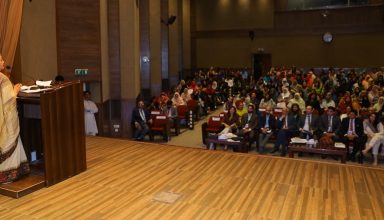'Migration for better opportunities is a fundamental human instinct': Director of The Goat Life

‘Migration for better opportunities is a fundamental human instinct’: Director of The Goat Life

In a soul-stirring sequence in Aadujeevitham or The Goat Life, the Malayalam-language film making waves before and after its release, the protagonist Najeeb (played with searing brilliance by Kerala superstar Prithviraj), clings to a small piece of stale homemade pickle, almost as if to clutch desperately to memories of the past amidst his horrifying present as a goat herder in an unforgiving desert. The scene symbolises hope and resilience; the human will to live being greater than the misery inflicted by man and nature.
The poignant scene is just one of the many in the survival drama that has made headlines as much for its compelling narrative as for its arduous journey to the theatres. Sixteen years in the making with a decade spent on scripting alone, a challenging shoot in Jordan marred by Covid-19, the astonishing physical transformation of its leading man, an exceptionally talented technical team led by Oscar winners A.R. Rahman and Resul Pookutty… there is much to unravel in The Goat Life, adapted from the bestselling novel by Benyamin. And the novel was based on the experiences of a sand miner from Kerala, Najeeb Muhammad, whose Gulf dream was shattered when failure in communication landed him on a desert in Saudi Arabia as a goat herder.

Given the visceral nature of the film, the impact on viewers has been mixed but it’s impossible to remain untouched by what one sees on screen. The fact that it’s a real-life story adds an extra layer to the reactions.
Perhaps that’s the biggest triumph of Blessy, the auteur whose steadfast commitment to narrate the story of Najeeb, results in a unique cinematic experience. For long, Blessy’s name has been associated with uncompromising, raw and honest storytelling, where his craft places human vulnerability above everything else.
Fortunately, the audience seems to have embraced his vision. Aadujeevitham received a wide release across Asia and the West and it’s marching towards INR 150-crore (over Dh66.5 million) at the box office. Edited excerpts from an interview with Blessy:
Aadujeevitham had tremendous hype ahead of its release and the buzz surrounding it remains palpable even now. Reflecting on its 16-year-journey, what sentiments arise for you now?
I feel that a new phase of the film has begun. From conceptualising the idea to translating the book into cinema, assembling a dedicated team, fine-tuning the music and navigating the shoot, each step was a march towards materialising a vision. When it finally hit the theatres last month, it dawned on me that what I had conceived 16 years ago is now in public domain. Now, be the emotions and questions it gives rise to, or the debates and discussions it generates, everything is the hands of the audience. The film has layers to be peeled off and that’s exactly how I envisioned it, not just as an entertainer but as art that gives rise to questions. I am immersed in that evolving phase now.

It was reported that at one point, you were considering making it in Tamil or Telugu. Given that their cinematic language is so different, could you have made The Goat Life with as much intensity in any other language than Malayalam?
Initially, I did feel that the scale and budget that a subject like this required might not be feasible in Malayalam. Even now, the film is doing well, but its commercial aspects need another conversation altogether. While the grammar of Tamil or Telugu cinema is more dramatic, the narratives explored in the film are universal. There are a lot of people from Tamil Nadu, for instance, who migrate to the Gulf. Migration for better opportunities is a fundamental human instinct rooted in hope that resonates across cultures.
In fact, the human experience transcends boundaries of nationality or community. I am glad that even Arab audiences are seeing the message in the way we intended.
Nature is the overriding element in The Goat Life. From the verdant greens of Kerala to the arid desert, a lot of scenes place nature at its centre. What were you trying to convey?
The various shades of nature add several layers to what you see on screen. The human body is deeply connected to nature and our experiences, politics and ethics are shaped by it. Najeeb mines sand from water, his mental makeup and perceptions are reflected by the wetness and greenery around him. From there, he reaches a point where he can’t get a drop of water. In one scene, you see that a small goat he herds understands his pain that men around him can’t. It’s this bond with an animal, with nature, that brings forth an element of compassion. During several screenings we had, this particular scene elicited applause from the audience.
Similarly, you had the character of Ibrahim Qadri, who turns out to be a criminal but it is his humanity that helps Najeeb escape. So there is something divine even in people who we’d normally consider ‘criminals’. These are the larger conversations, I hope, the film continues to inspire.

How will the process of this film impact your future projects?
I make all films with equal pain and intensity. A certain kind of cinema demands a certain kind of emotion and investment. But I am aware that the industry is changing with technology becoming all-pervasive in art. Today, more than a social message platform, cinema is about a grand theatrical experience with the spectacle or sound and visuals accompanying it. So, your storytelling has to be planned on a bigger scale. Family dramas, I believe, will be more apt for OTT or as web series. The challenge for filmmakers like me is to understand these changes and evolve accordingly.
The film is visually stunning with a haunting score and sound design. Which sequence was the most challenging to shoot?
Everything! We didn’t head into the making of the film thinking that any of the scenes would be impossible to shoot. Our idea was, we have to make it possible. For instance, when we needed snakes for a scene, we tried to figure out ways to secure desert snakes without using VFX. Isn’t that the challenge and magic of filmmaking?

One of the observations against the film pertains to its length. Was it necessary to prolong the experience for the viewer?
The length became a talking point because of certain cinematic choices we made. I believed that the desert crossing sequences lie at the core of the film. The rest of the drama may have been familiar, but it was this part that would elevate the film. Ibrahim Qadri was no longer there, Najeeb was on his own trying to make it across the desert and we decided to not add music to this part. This may have created a lag among viewers. The BGM starts only when he hears the sound of the vehicle and starts running again. We wanted the audience to feel the psychological discomfort and frustration.
Malayalam cinema has had a great year so far and the success of content-driven cinema has often been credited to the sensibilities of the audience. Do you think the audience defines the cinema or is the opposite true?
The defining trait of Kerala audiences is that they are very well aware of their cultural roots, flavours, tastes and stories. In fact, the whole of India is so diverse! But in Kerala, we have a huge background of literature and a rich tradition of theatre that shape our politics and life. Another factor is the film society culture we promote. After Kolkata, it is Kerala that celebrates film societies. I am product of such societies and have learnt cinema from the likes of Adoor Gopalakrishnan, Aravindan, John Abraham and other legends. This is why filmmakers, even young directors today, are able to reach larger audiences through the strength of their stories.
wknd@khaleejtimes.com
ALSO READ:
source: khaleejtimes


